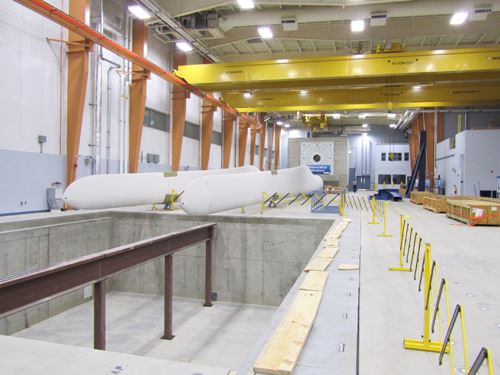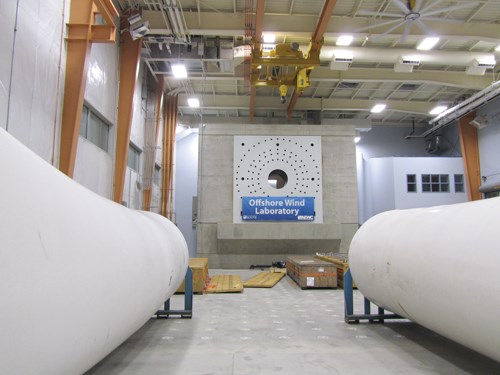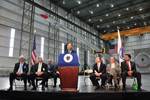UMaine’s Offshore Wind lab sports 70m/230-ft testing … and more
The Offshore Wind Laboratory’s new wind turbine blade test lab, part of a 38,700-ft² (3,595m²) expansion of the University of Maine’s (UMaine) AEWC Advanced Structures and Composites Center (Orono, Maine), was first announced in February 2009.
The Offshore Wind Laboratory’s new wind turbine blade test lab, part of a 38,700-ft² (3,595m²) expansion of the University of Maine’s (UMaine) AEWC Advanced Structures and Composites Center (Orono, Maine), was first announced in February 2009. Construction of the lab began in earnest during summer 2010. The lab was completed in late November 2011, the equipment was calibrated and tested, and commercial clients were able to use its services beginning in spring of this year. The lab received certification in August 2012 and, according to the lab’s director Dr. Habib Dagher, it has already been used by several “top 10” wind energy OEMs.
Dagher emphasizes that the AEWC lab is a full-service facility, offering testing and material characterization services that cover each stage of blade development, including coupons, spars, root sections, blade sections and complete blades.
The lab’s blade test fixture (see photo) is anchored in bedrock and stabilized by more than 4.5 million lb (2,041 metric tonnes) of steel and concrete. The lab can provide up to 1 million lb (453.6 metric tonnes) of fatigue and static loads and is capable of testing up to 70m/230-ft long wind blades. In North America, the Offshore Wind Laboratory is second in size only to the Wind Technology Testing Center (WTTC, Boston, Mass.). The AEWC lab also includes what Dagher says is one of the largest environmental chambers in the U.S., capable of measuring static and fatigue characteristics under a variety of temperatures, humidity levels and UV light exposures.
The AEWC’s new wave and wind basin is under construction and due to be completed by the end of 2013; it will allow for the testing of wind turbines in an offshore environment under wave and wind conditions. The tank will be 130 ft long, 75 ft wide and 15 ft deep (39.6m by 22.9m by 4.6m) and will be able to propagate waves at a different angle than the wind. When all is said and done, the AEWC lab will encompass 100,000 ft²/9,290m² and cost $100 million.
As part of the AEWC’s efforts to develop offshore wind energy systems, Dagher says the organization is manufacturing a 1:8-scale floating turbine that is expected to be completed by April 2013. It will feature a composite tower, and composites will be used in some parts of the floating structure. Dagher says it will be tested in the Atlantic Ocean off the coast of Maine from April to September 2013.
Unlike the WTTC, which is allied with the U.S. Department of Energy’s National Renewable Energy Laboratory (Golden, Colo.), the UMaine facility operates independently. Reportedly, 90 percent of its operational funding comes from grants and its outside income. The construction project benefited from a total of $17.4 million (USD) in funding provided by a Maine bond issue, the Maine Technology Asset Fund and the National Institute of Standards and Technology (NIST).
Related Content
-
Moving toward next-generation wind blade recycling
Suppliers, fabricators and OEMs across the composite wind blade supply chain ramp up existing technologies, develop better reclamation methods and design more recyclable wind blades.
-
Forvia brand Faurecia exhibits XL CGH2 tank, cryogenic LH2 storage solution for heavy-duty trucks
Part of its full hydrogen solutions portfolio at IAA Transportation 2022, Faurecia also highlighted sustainable thermoplastic tanks and smart tanks for better safety via structural integrity monitoring.
-
Materials & Processes: Fibers for composites
The structural properties of composite materials are derived primarily from the fiber reinforcement. Fiber types, their manufacture, their uses and the end-market applications in which they find most use are described.
















